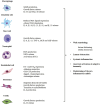The innate face of Giant Cell Arteritis: Insight into cellular and molecular innate immunity pathways to unravel new possible biomarkers of disease
- PMID: 39086970
- PMCID: PMC11285707
- DOI: 10.3389/fmmed.2022.933161
The innate face of Giant Cell Arteritis: Insight into cellular and molecular innate immunity pathways to unravel new possible biomarkers of disease
Abstract
Giant cell arteritis (GCA) is an inflammatory chronic disease mainly occurring in elderly individuals. The pathogenesis of GCA is still far from being completely elucidated. However, in susceptible arteries, an aberrant immune system activation drives the occurrence of vascular remodeling which is mainly characterized by intimal hyperplasia and luminal obstruction. Vascular damage leads to ischemic manifestations involving extra-cranial branches of carotid arteries, mostly temporal arteries, and aorta. Classically, GCA was considered a pathological process resulting from the interaction between an unknown environmental trigger, such as an infectious agent, with local dendritic cells (DCs), activated CD4 T cells and effector macrophages. In the last years, the complexity of GCA has been underlined by robust evidence suggesting that several cell subsets belonging to the innate immunity can contribute to disease development and progression. Specifically, a role in driving tissue damage and adaptive immunity activation was described for dendritic cells (DCs), monocytes and macrophages, mast cells, neutrophils and wall components, such as endothelial cells (ECs) and vascular smooth muscle cells (VSMCs). In this regard, molecular pathways related to cytokines, chemokines, growth factors, vasoactive molecules and reactive oxygen species may contribute to the inflammatory process underlying GCA. Altogether, innate cellular and molecular pathways may clarify many pathogenetic aspects of the disease, paving the way for the identification of new biomarkers and for the development of new treatment targets for GCA. This review aims to deeply dissect past and new evidence on the innate immunological disruption behind GCA providing a comprehensive description of disease development from the innate perspective.
Keywords: biomarkers; cytokines; endothelial damage; giant cell arteritis; growth factors; inflammation; innate immunity; reactive oxygen species.
Copyright © 2022 Rizzo, La Barbera, Miceli, Tuttolomondo and Guggino.
Conflict of interest statement
The authors declare that the research was conducted in the absence of any commercial or financial relationships that could be construed as a potential conflict of interest.
Figures

Similar articles
-
New insights into the pathogenesis of giant cell arteritis.Autoimmun Rev. 2017 Jul;16(7):675-683. doi: 10.1016/j.autrev.2017.05.004. Epub 2017 May 4. Autoimmun Rev. 2017. PMID: 28479485 Review.
-
Giant Cell Arteritis: Advances in Understanding Pathogenesis and Implications for Clinical Practice.Cells. 2024 Jan 31;13(3):267. doi: 10.3390/cells13030267. Cells. 2024. PMID: 38334659 Free PMC article. Review.
-
Pathogenesis of giant cell arteritis: More than just an inflammatory condition?Autoimmun Rev. 2010 Aug;9(10):635-45. doi: 10.1016/j.autrev.2010.05.002. Epub 2010 May 8. Autoimmun Rev. 2010. PMID: 20457278 Review.
-
[Giant-cell arteritis pathogenesis].Presse Med. 2012 Oct;41(10):937-47. doi: 10.1016/j.lpm.2012.07.005. Epub 2012 Aug 14. Presse Med. 2012. PMID: 22902103 Review. French.
-
Recent advances in our understanding of giant cell arteritis pathogenesis.Autoimmun Rev. 2017 Aug;16(8):833-844. doi: 10.1016/j.autrev.2017.05.014. Epub 2017 May 28. Autoimmun Rev. 2017. PMID: 28564617 Review.
Cited by
-
Correlation and Risk Assessment of Inflammation-Based Parameters on Cardiovascular Parameters and Clinical Events in Giant Cell Arteritis: A Retrospective Study.Int J Mol Sci. 2025 Jul 21;26(14):7016. doi: 10.3390/ijms26147016. Int J Mol Sci. 2025. PMID: 40725261 Free PMC article.
-
Targeting cholesterol-driven pyroptosis: a promising strategy for the prevention and treatment of atherosclerosis.Mol Biol Rep. 2025 May 15;52(1):459. doi: 10.1007/s11033-025-10554-8. Mol Biol Rep. 2025. PMID: 40372511 Review.
-
The Contribution of Innate Immunity in Large-Vessel Vasculitis: Detangling New Pathomechanisms beyond the Onset of Vascular Inflammation.Cells. 2024 Feb 1;13(3):271. doi: 10.3390/cells13030271. Cells. 2024. PMID: 38334663 Free PMC article. Review.
-
Vascular-adhesion protein 1 in giant cell arteritis and polymyalgia rheumatica.Front Med (Lausanne). 2024 Aug 14;11:1448157. doi: 10.3389/fmed.2024.1448157. eCollection 2024. Front Med (Lausanne). 2024. PMID: 39206172 Free PMC article. Review.
-
Factors Influencing Venous Remodeling in the Development of Varicose Veins of the Lower Limbs.Int J Mol Sci. 2024 Jan 26;25(3):1560. doi: 10.3390/ijms25031560. Int J Mol Sci. 2024. PMID: 38338837 Free PMC article. Review.
References
-
- Álvarez Rodríguez L., López-Hoyos M., Mata C., Fontalba A., Calvo Alen J., Marín M. J., et al. (2011). Expression and function of toll-like receptors in peripheral blood mononuclear cells of patients with polymyalgia rheumatica and giant cell arteritis. Ann. Rheum. Dis. 70 (9), 1677–1683. 10.1136/ard.2010.140194 - DOI - PubMed
-
- Barman S. A., Chen F., Su Y., Dimitropoulou C., Wang Y., Catravas J. D., et al. (2014). NADPH oxidase 4 is expressed in pulmonary artery adventitia and contributes to hypertensive vascular remodeling. Arterioscler. Thromb. Vasc. Biol. 34 (8), 1704–1715. Epub 2014 Jun 19. PMID: 24947524. 10.1161/ATVBAHA.114.303848 - DOI - PMC - PubMed
Publication types
LinkOut - more resources
Full Text Sources
Research Materials
Miscellaneous

